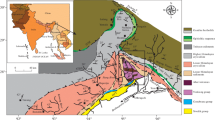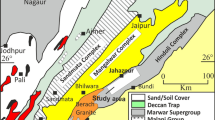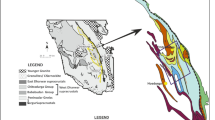Abstract
The Mesoarchaean Iron Ore Group (IOG) of rocks in Bonai-Keonjhar belt is disposed in a horseshoe shaped synclinorium structure in the western part of the Singhbhum Craton. Morphology of this synclinorium is expressed by a near continuous western ridge and dissected eastern highlands with the broad Jamda-Koira valley at the centre. Detailed structural analysis in the northern part of the belt suggests that the synclinorium is in fact a series of NE-SW to NNESSW trending shallow plunging, second generation (D2) syncline and anticline which have overturned, inclined, relatively tight geometry in the western part and upright, open to gentle in the eastern part. This structure is clearly manifested by synclinal ridges and anticlinal valleys. Evidence of an early deformational event (D1) manifested by the presence of isoclinal folds on outcrop scale has been recorded. D1 and D2 are near co-axial. The last deformational event (D3) has led to dome and basin interference pattern due to cross folding along NW-SE striking axial planes. The volcano-sedimentary package in the belt commenced with platformal package represented by basic volcanic-quartzite association. The Bonai range volcanic, Nuakot volcanic and the Jagannathpur volcanic occurring in the western, southern and eastern parts of the belt has been interpreted to be correlatable representing the basal volcanic suite. The linear body of basic volcanic occurring at the central part of the belt is found to be occupying the core part of a shallow plunging anticlinal axial trace and thus has also been equated with the basal volcanic suite. There is but only one major BIF horizon in the Bonai- Keonjhar belt which has been structurally repeated across the belt, BIF occurring as NNE-SSW trending synclinal ridges flanked on either side by the older phyllitic sequences.
Similar content being viewed by others
References
Acharya, S.K. (1993) Greenstones from Singhbhum, their Archaean character, oceanic crust affinity and tectonics. Proc. National Acad. Sci., India, v.A-63, pp.211–222.
Banerjee, P.K. (1982) Stratigraphy, Petrology and geochemistry of some Precambrian basic volcanicand associated rocks of Singhbhum district, Bihar and Mayurbhanj and Keonjhar district, Orissa. Mem. Geol. Surv. India, v.111, pp.1–54
Chatterjee, A.K. and Mukherjee, P.K. (1981) The structural set up of a part of the Malangtoli iron ore deposit, Orissa. Jour. Geol. Soc. India, v.22, pp.121–130
Dunn, J.A. (1940) Stratigraphy of south Singhbhum, Mem. Geol. Surv. India, v.63, pp.303–389.
Dunn, J.A. and Dey, A.K. (1942) The geology and petrology of eastern Singhbhum and surrounding areas. Mem. Geol. Surv. India, v.69, pp.281–450
Ghosh, G. and Mukhopadhyay, J. (2007) Reappraisal of the structure of the Western Iron Ore Group, Singhbhum craton, eastern India: implication for the exploration of BIF hosted iron ore deposits. Gondwana Res., v.12, pp.525–532.
Ghosh, G., Kumari, S., Patil, S.K., Mukhopadhyay, J. and Ray, A. (2009) Superposed deformation fabrics in the Precambrian metabasic rocks of the Iron Ore Group, Singhbhum craton, Eastern India: Evidences from anisotropy of magnetic susceptibility studies. Jour. Struct. Geol., v. 32(2), pp.249–261.
Iyenger, S.V.P. and Murthy, Y.G.K. (1982) The evolution of the Archaean Proterozoic crust in parts of Bihar and Orissa, eastern India. Rec. Geol. Surv. India, v.112, pp.1–5
Jena, B.K. and Behera, U.K. (2000) The oldest supracrustal belt from Singhbhum craton and its possible correlation. Geol. Surv. India Spec. Publi., v.57, pp.106–121.
Jones, H.C. (1934). The iron ore deposits of Bihar and Orissa. Mem. Geol. Surv. India, v.63, pp.357.
Mohakul, J.P. and Bhutia, S.P. (2011) Final report on Reappraisal of structure and stratigraphy of iron ore belt of horse shoe basin. Geol. Surv. India Unpubld. Progress Report.
Mohanty, M.R., Behera, S.N. and Rath, S.C. (2003) Final report on the structural disposition of the iron ore bodies in iron ore basin of Sundergarh-Kendujhar districts, Orissa. (In parts of Toposheets 73 G/1 and G/5). Geol. Surv. India Unpubld. Progress Report.
Mukhopadhyay, D. (2001) The Archaean nucleus of Singhbhum: the present state of knowledge. Gondwana Res, v.4, pp.307–318.
Mukhopadhyay, J., Beukes, N.J., Armstrong, R.A., Zimmermann, U., Ghosh, G. and Medda, R.A. (2008) Dating the oldest greenstone in India: a 3.51-Ga precise U-Pb SHRIMP zircon age for dacitic lava of the southern Iron Ore Group, Singhbhum craton. Jour. Geol., v.116, pp. 449–61.
Murthy, V.N and Acharya, S. (1975) Lithostratigraphy of the Precambrian rocks around Koira, Sundergarh district, Orissa, Jour. Geol. Soc. India, v.16, pp.55–68.
Prasad Rao, G.H.S.V., Myrthy, Y.G.K. and Deekshitulu, M.N. (1964) Stratigraphic relations of Precambrian iron formations and associated sedimentary sequences in parts of Keonjhar, Cuttack, Dhenkanal and Sundergarh districts, Orissa, India. Proc. Int. Geol. Congress, 22nd session, part 10, pp.72–78.
Saha, A.K. (1994) Crustal evolution of Singhbhum North Orissa, Eastern India. Mem. Geol. Soc. India, No.27, pp.339.
Sarkar, S.N. and Saha, A.K. (1962) A revision of the Precambrian stratigraphy and tectonics of Singhbhum and adjacent regions. Quart. Jour. Geol. Min. Metal. Soc. India, v.34, pp.97–136.
Sarkar, S.N. and Saha, A.K., (1963) On the occurrence of two intersecting Precambrian orogenic belts in Singhbhum and adjacent areas, India, Geol, Mag., v.100, pp.69–92.
Sarkar, S.N. and Saha, A.K. (1977) The present status of Precambrian stratigraphy, tectonics and geochronology of Singhbhum-Keonjhar- Mayurbhanj region, Eastern India, Indian Jour. Earth Sci., S. Ray Volume, pp.37–65.
Sarkar, S.N. and Saha, A.K., (1983) Structure and tectonics of the Singhbhum-Orissa iron ore craton, eastern India. In: S. Sinha-Roy (Ed.), Structure and tectonics of the Precambrian rocks. Recent Researches in Geology, v.10. Hindustan Publ. Co., Delhi, pp.1–25.
Sarangi, S.K. and Acharya, S. (1975) Stratigraphy of the Iron Ore Group around Khandadhar, Sundargarh district, Orissa. Indian Jour. Earth Sci., v.2(2), pp.182–189.
Sengupta, S., Acharya, S.K. and de Smith, J.B. (1997) Geochemistry of Archean volcanic rocks from Iron Ore Supergroup, eastern India. Proc. Indian Acad. Sci., v.106, pp.327–342.
Tait, Jennifer., Zimmermann, U., Miyajaki T., Presnyakov, S., Chang, Q., Mukhopadhyay, J. and Sergeev, S. (2011) Possible juvenile Palaeoarchaean TTG magmatism in eastern India and its constraints for the evolution of the Singhbhum craton. Geol. Mag., v.148(2), pp.340–347.
Author information
Authors and Affiliations
Corresponding author
Rights and permissions
About this article
Cite this article
Mohakul, J.P., Bhutia, S.P. Regional structural analysis and reinterpretation in the Bonai-Keonjhar Belt, Singhbhum craton: Implication for revision of the lithostratigraphic succession. J Geol Soc India 85, 26–36 (2015). https://doi.org/10.1007/s12594-015-0191-x
Received:
Accepted:
Published:
Issue Date:
DOI: https://doi.org/10.1007/s12594-015-0191-x




